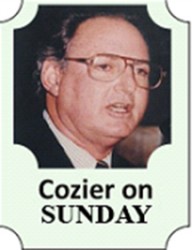
Their bowling consultant based his opinion on the presence in the team of the number of specialists from global T20 franchise tournaments, the majority of whom were in the champion team in 2012 that depressed home support by defeating Sri Lanka in the final in Colombo. Most were also there in 2014 in Bangladesh when the result was reversed in the semi-final by the weather, the Duckworth/Lewis system and Sri Lankan opposition intent on avoiding a repeat.
As much as the two are unrelated, the feel-good factor of the Under-19s unexpected success in their recent 50-overs World Cup adds to the optimism that contrasts so markedly with their dismal status in the longer formats.
The belated settlement of the leading players’ initial disquiet over terms of their contracts, confirmed by their eventual signatures on the dotted line, was another of Ambrose’s reasons for hopeful expectation. It is not often of late that the West Indies enter a tournament with every one seemingly on the same page.
Although he remains upbeat after successive victories in warm-up matches in Dubai, two over Zimbabwe, one over English county Warwick-shire, optimism has been tempered by recent developments.
Since the squad of 15 was announced, Sunil Narine, still not satisfied that he has managed to correct his prohibited action, Kieron Pollard, with a chronic knee problem, and Darren Bravo, whose intention now is to focus solely in future on Test cricket, all chose to opt out.
These were followed over the past week by the elimination of Lendl Simmons who returns to Trinidad to seek treatment on a back injury and the revelation that Andre Russell faces a possible two-year ban for missing three mandatory drug tests in a 12-month period.
Narine, Darren Bravo, Russell and Simmons were on the team in both 2012 and 2014; Pollard, there in 2012, was eliminated by injury two years later.
Their absence in India would clearly diminish the team’s strength, none more so than Narine’s.
He was crucial to the West Indies’ advance in the two previous tournaments. He conjured up 17 wickets in the 13 matches with his mesmerising, each-way spin at an average of 14.7 runs each and an economy rate of 5.16. In 34 T20 Internationals his record is 40 wickets, at a 17.75 average and a 5.69 economy rate.
There could be no other Player of the Final in 2012 than Marlon Samuels for his astonishing 78 off 56 balls with six sixes that transformed a stuttering innings; Narine’s 3.4-0-9-3 was a major contribution to Sri Lanka’s rout for 101 going after 137 for six.
When the ICC put his career on hold following the two T20s against Sri Lanka in Sri Lanka last October, he was atop both the ODI and T20 Inter-national rankings. It seems unlikely that he will be the same again, a loss as much to the West Indies as to the world game.
While Russell is unlikely to be banned from the tournament as a result of the Jamaica Anti-Doping Commission (JADCO) finding, it has cast an ominous shadow over him. His all-round electricity as power-hitter, wicket-taker and fleet-footed boundary rider, allied to his experience of Indian conditions in the IPL, render him a key member of the squad. Carlos Brathwaite, already chosen to fill the breach left by Pollard, is a like-for-like in every regard except for familiarity with India where is yet to play.
Simmons’ run-rate of 113.9, based on 26 sixes in 34 T20 Internationals, combined with his IPL credentials, made him key at the top of the order. Dwayne Smith, a seasoned T20 campaigner with similar attributes, was in the 2012 and 2014 tournaments; he appears the clear choice to take Simmons’ place.
Unsurprisingly, there was no ready understudy for Narine. Ashley Nurse, a useful off-spinner with the limited experience of four wicketless, T20 Inter-nationals, has been brought in and Sulieman Benn, the skyscraper left-arm spinner, recalled.
Such enforced stags place additional responsibilities on Darren Sammy’s captaincy, Samuel Badree’s canny mixture of leg-breaks, googlies and straight balls, the batting of the self-styled ‘boss’ Chris Gayle and Samuels and, as far as Ambrose is concerned, most of all the proven all-round skills and passion of Dwayne Bravo.
“Dwayne Bravo is a superstar, no doubt about it,” he enthused after Bravo’s performances in Dubai. “He understands T20 cricket and is going to be a tremendous asset to us in the World Cup.”
“There isn’t much I can say to him about his bowling,” Ambrose conceded, a flattering comment from one with 405 Test wickets to his name whose televised, animated admonishing to his charges before they take the field indicate he usually has a lot to say.
Bravo, he added, was also a motivator he expects to “lead the other bowlers along.”
All in all, it was rare endorsement of an individual player.
Gayle is 36, Samuels and Badree 35, Bravo 32, Sammy 31. Gayle and Bravo remain top performers yet their careers are winding down. Sammy sees the realisation that the over-30s are unlikely to participate in another global tournament as motivation to make this one special.
Their first objective is to get past England, Sri Lanka and South Africa, the top teams, in a group also including a qualifier. They have prevailed 2-1 in their previous T20s against England in the Caribbean in 2014 and South Africa in South Africa in January 2015 and shared two with Sri Lanka last October.
All three, significantly changed in personnel and strength since, now offer different challenges. For all the West Indies’ own enforced alterations, elimination in the first round would be a further disaster of which there has been a surfeit.
For the first time, the tournament offers two for the price of one as the women simultaneously compete for their championship. Second to Australia in the league table for the women’s championship, the West Indies’ progress will be keenly followed on both fronts.





